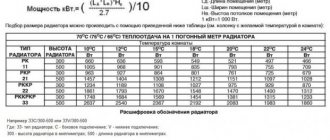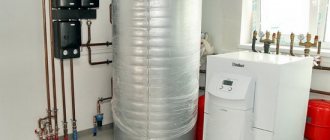OGE 2022 in physics ›
1. The change in internal energy by doing work is characterized by the amount of work, i.e. work is a measure of the change in internal energy in a given process. The change in the internal energy of a body during heat transfer is characterized by a quantity called the amount of heat .
The amount of heat is the change in the internal energy of a body during the process of heat transfer without doing work.
The amount of heat is denoted by the letter \( Q \). Since the amount of heat is a measure of the change in internal energy, its unit is the joule (1 J).
When a body transfers a certain amount of heat without doing work, its internal energy increases; if the body gives off a certain amount of heat, then its internal energy decreases.
2. If you pour 100 g of water into two identical vessels, one and 400 g into the other at the same temperature and place them on identical burners, then the water in the first vessel will boil earlier. Thus, the greater the mass of a body, the greater the amount of heat it requires to heat up. The same is true with cooling: when a body of greater mass is cooled, it gives off a greater amount of heat. These bodies are made of the same substance and they heat up or cool down by the same number of degrees.
\[Q\sim m\]
3. If we now heat 100 g of water from 30 to 60 °C, i.e. at 30 °C, and then up to 100 °C, i.e. by 70 °C, then in the first case it will take less time to heat up than in the second, and, accordingly, heating water by 30 °C will require less heat than heating water by 70 °C. Thus, the amount of heat is directly proportional to the difference between the final \( (t_2\,^\circ C) \) and initial \( (t_1\,^\circ C) \) temperatures: \( Q\sim(t_2- t_1)\).
4. If you now pour 100 g of water into one vessel, and pour a little water into another identical vessel and put in it a metal body such that its mass and the mass of water are 100 g, and heat the vessels on identical tiles, then you will notice that in a vessel containing only water will have a lower temperature than one containing water and a metal body. Therefore, in order for the temperature of the contents in both vessels to be the same, it is necessary to transfer more heat to the water than to the water and the metal body. Thus, the amount of heat required to heat a body depends on the type of substance from which the body is made.
5. The dependence of the amount of heat required to heat a body on the type of substance is characterized by a physical quantity called the specific heat capacity of the substance .
A physical quantity equal to the amount of heat that must be imparted to 1 kg of a substance to heat it by 1 ° C (or 1 K) is called the specific heat capacity of the substance.
1 kg of substance releases the same amount of heat when cooled by 1 °C.
Specific heat capacity is denoted by the letter \( c \). The unit of specific heat capacity is 1 J/kg °C or 1 J/kg K.
The specific heat capacity of substances is determined experimentally. Liquids have a higher specific heat capacity than metals; Water has the highest specific heat, gold has a very small specific heat.
The specific heat of lead is 140 J/kg °C. This means that to heat 1 kg of lead by 1 °C it is necessary to expend an amount of heat of 140 J. The same amount of heat will be released when 1 kg of water cools by 1 °C.
Since the amount of heat is equal to the change in the internal energy of the body, we can say that specific heat capacity shows how much the internal energy of 1 kg of a substance changes when its temperature changes by 1 °C. In particular, the internal energy of 1 kg of lead increases by 140 J when heated by 1 °C, and decreases by 140 J when cooled.
The amount of heat \( Q \) required to heat a body of mass \( m \) from temperature \( (t_1\,^\circ C) \) to temperature \( (t_2\,^\circ C) \), is equal to the product of the specific heat capacity of the substance, body mass and the difference between the final and initial temperatures, i.e.
\[ Q=cm(t_2{}^\circ-t_1{}^\circ) \]
The same formula is used to calculate the amount of heat that a body gives off when cooling. Only in this case should the final temperature be subtracted from the initial temperature, i.e. Subtract the smaller temperature from the larger temperature.
6. An example of solving a problem. 100 g of water at a temperature of 20 °C is poured into a glass containing 200 g of water at a temperature of 80 °C. After which the temperature in the vessel reached 60 °C. How much heat did the cold water receive and how much heat did the hot water give out?
When solving a problem, you must perform the following sequence of actions:
- write down briefly the conditions of the problem;
- convert the values of quantities to SI;
- analyze the problem, establish which bodies are involved in heat exchange, which bodies give off energy and which receive;
- solve the problem in general form;
- perform calculations;
- analyze the received answer.
1. The task.
Given: \( m_1 \) = 200 g \( m_2 \) = 100 g \( t_1 \) = 80 °C \( t_2 \) = 20 °C \( t \) = 60 °C ______________
\( Q_1 \) — ? \( Q_2 \) — ? \( c_1 \) = 4200 J/kg °C
2. SI: \( m_1 \) = 0.2 kg; \( m_2 \) = 0.1 kg.
3. Task analysis. The problem describes the process of heat exchange between hot and cold water. Hot water gives off an amount of heat \( Q_1 \) and cools from temperature \( t_1 \) to temperature \( t \). Cold water receives an amount of heat \( Q_2 \) and is heated from temperature \( t_2 \) to temperature \( t \).
4. Solution of the problem in general form. The amount of heat given off by hot water is calculated by the formula: \( Q_1=c_1m_1(t_1-t) \).
The amount of heat received by cold water is calculated by the formula: \(Q_2=c_2m_2(t-t_2)\).
5. Computing. \( Q_1 \) = 4200 J/kg · °С · 0.2 kg · 20 °С = 16800 J \( Q_2 \) = 4200 J/kg · °С · 0.1 kg · 40 °С = 16800 J
6. The answer is that the amount of heat given off by hot water is equal to the amount of heat received by cold water. In this case, an idealized situation was considered and it was not taken into account that a certain amount of heat was used to heat the glass in which the water was located and the surrounding air. In reality, the amount of heat given off by hot water is greater than the amount of heat received by cold water.
Formula for calculating the amount of heat
Let’s say you need to find out how much heat an iron part received when heated. The mass of the part is $3 \space kg$. The part heated from $20 \degree C$ to $300 \degree C$.
Let's take the value of the heat capacity of iron from the table - $460 \frac{J}{kg \cdot \degree C}$. Let us explain the meaning of this value: to heat a piece of iron weighing $1 \space kg$ by $1 \degree C$ it is necessary to expend an amount of heat equal to $460 \space J$.
- The mass of the part is 3 times greater, which means that heating it will require 3 times the amount of heat - $1380 \space J$
- The temperature changed not by $1 \degree C$, but by $280 \degree C$
- This means that 280 times more heat is needed: $1380 \space J \cdot 280 = 386,400 \space J$
Then, the formula for calculating the amount of heat required to heat a body or released by it during cooling will take the form:
$Q = cm(t_2 - t_1)$,
where $Q$ is the amount of heat, $c$ is the specific heat capacity of the substance of which the body is composed, $m$ is the mass of the body, $t_1$ is the initial temperature of the body, $t_2$ is the final temperature of the body.
To calculate the amount of heat that must be expended to heat a body or released by it during cooling, the specific heat capacity must be multiplied by the mass of the body and by the difference between the final and initial temperatures.
Let us consider in more detail the features of calculating the amount of heat using examples of problem solving.
Specific heat capacity of a substance
It is a physical quantity that expresses the amount of heat required by a substance per unit mass to increase its temperature by one unit.
Thus, specific heat capacity is a property of a substance because its value is representative of each substance, each of which in turn has different values depending on what state it is in (liquid, solid, or gas).
Specific heat capacity is denoted by the small letter c and is measured in J/kg∗°C, and is the coefficient of temperature increase in one unit of the entire system or the entire mass of a substance.
In addition, specific heat capacity varies depending on the physical state of a substance, especially in the case of solid particles and gases, since its molecular structure affects heat transfer in the particle system. The same applies to atmospheric pressure conditions: the higher the pressure, the lower the specific heat.
The basic composition of the specific heat of a substance should be c = C/m, i.e., the specific heat is equal to the ratio of calorie content and mass.
However, when this is applied to a given temperature change, it is said to be average specific heat capacity, which is calculated based on the following formula:
Where:
Q is the transfer of thermal energy between the system and the environment (J);
m is the mass of the system (kg);
Δt or (t2 - t1) is the increase in temperature to which it is exposed (°C).
Formula for finding the amount of heat Q:
Q = c∗m(t 2
- t 1 )
The higher the specific heat capacity of a substance, the more thermal energy is required for its temperature to increase. For example, heating water (lead = 4200 J/kg∗°C) will require more thermal energy than heating lead (lead = 140 J/kg∗°C).
Heat balance equation:
Q given + Q received = 0.
Below is a table of specific heat capacity values for some substances:
Calculation of the amount of heat spent on heating two bodies
Water with a mass of $10 \space kg$ was poured into an iron pot with a mass of $4 \space kg$ (Figure 1). Their temperature is $25 \degree C$. How much heat is needed to heat the pot and water to a temperature of $100 \degree C$?
Figure 1. Heating water in a pot.
Please note that two bodies will heat up at once : both the pot and the water in it. There will be constant heat exchange . Therefore, we can consider their temperatures to be the same.
Note that the masses of the pot and water are different. They also have different heat capacities. This means that the amounts of heat they receive will be different .
Now we can write down the condition of the problem and solve it.
Given: $m_1 = 4 \space kg$ $c_1 = 460 \frac{J}{kg \cdot \degree C}$ $m_2 = 10 \space kg$ $c_2 = 4200 \frac{J}{kg \cdot \ degree C}$ $t_1 = 25 \degree C$ $t_2 = 100 \degree C$
Q-?
View solution and answer
Hide
Solution:
To calculate the amount of heat received, we use the formula $Q = cm(t_2 - t_1)$.
Let's write this formula for the amount of heat received by the boiler: $Q_1 = c_1m_1(t_2 - t_1)$.
Let's calculate this amount of heat: $Q_1 = 460 \frac{J}{kg \cdot \degree C} \cdot 4 \space kg \cdot (100 \degree C - 25 \degree C) = 1840 \frac{J}{\ degree C} \cdot 75 \degree C = 138,000 \space J = 138 \space kJ$.
The amount of heat received by water when heated will be equal to: $Q_2 = c_2m_2(t_2 - t_1)$.
Let's substitute the numerical values and calculate: $Q_2 = 4200 \frac{J}{kg \cdot \degree C} \cdot 10 \space kg \cdot (100 \degree C - 25 \degree C) = 42000 \frac{J}{ \degree C} \cdot 75 \degree C = 3,150,000 \space J = 3150 \space kJ$.
The total amount of heat spent on heating the boiler and water: $Q = Q_1 +Q_2$, $Q = 138 \space kJ + 3150 \space kJ = 3288 \space kJ$.
Answer: $Q = 3288 \space kJ$.
How are the amount of heat and specific heat related and how do they differ?
We will consider processes such as heating and cooling.
- heating - the body receives thermal energy (amount of heat).
- cooling - the body releases thermal energy into the surrounding space.
Thanks to the processes of heating and cooling, we can heat ourselves in winter using a Russian stove. First, the stove will receive the amount of heat (thermal energy) from the burning fuel - firewood. And then, it will cool down and give off this amount of heat to all bodies in the room.
Differences between specific heat capacity and amount of heat
To remember what the amount of heat is and how it differs from specific heat capacity, you can do this (Fig.):
Rice. 4. Specific heat capacity and amount of heat are energies; they correspond to different numbers of degrees and number of kilograms
- The amount of heat is the energy of heating (cooling) several kilograms by several degrees.
- Specific heat capacity is the energy of heating 1 kilogram by 1 degree.
The relationship between the amount of heat and specific heat capacity - formula
If known:
- specific heat capacity of a substance;
- number of kilograms of substance;
- the number of degrees to which the substance must be heated,
then it is easy to calculate the total thermal energy - i.e. the amount of heat.
To do this we use the formula:
\[\large \boxed{ Q = c \cdot m \cdot (t_{\text{end}} - t_{\text{start}}) }\]
\(\large Q \left( \text{J} \right) \) – amount of heat, i.e. total thermal energy;
\(\large c \left( \frac{\text{J}}{\text{kg} \cdot \text{deg}} \right) \) – specific heat capacity;
\(\large m \left( \text{kg} \right) \) – mass of the substance;
\(\large t_{\text{final}} \left( \text{deg} \right) \) – temperature after heating;
\(\large t_{\text{start}} \left( \text{deg} \right) \) – temperature before heating;
Calculation of the amount of heat when mixing liquids
Hot water was diluted with cold water and the temperature of the mixture was $30 \degree C$. Hot water with a temperature of $100 \degree C$ was $0.3 \space kg$. The cold water had a mass of $1.4 \space kg$ and a temperature of $15 \degree C$. Calculate how much heat was given up by hot water when cooling and received by cold water when heated. Compare these amounts of heat.
Given: $c_1 = c_2 = c = 4200 \frac{J}{kg \cdot \degree C}$ $m_1 = 0.3 \space kg$ $m_2 = 1.4 \space kg$ $t_1 = 100 \degree C$ $t_2 = 15 \degree C$ $t = 30 \degree C$
$Q_1 — ?$ $Q_2 — ?$
View solution and answer
Hide
Solution:
Let's write a formula for calculating the amount of heat given off by hot water when cooling from $100 \degree C$ to $30 \degree C$: $Q_1 = cm_1(t_1 - t)$.
Let's calculate this value: $Q_1 = 4200 \frac{J}{kg \cdot \degree C} \cdot 0.3 \space kg \cdot (100 \degree C - 30 \degree C) = 1260 \frac{J}{\degree C} \cdot 70 \degree C = 88 200 \space J = 88.2 \space kJ$.
Let's write a formula for calculating the amount of heat received by cold water when heated from $15 \degree C$ to $30 \degree C$: $Q_2 = cm_2(t - t_2)$.
Let's calculate this value: $Q_1 = 4200 \frac{J}{kg \cdot \degree C} \cdot 1.4 \space kg \cdot (30 \degree C - 15 \degree C) = 5880 \frac{J}{\degree C} \cdot 15 \degree C = 88 200 \space J = 88.2 \space kJ$.
$Q_1 = Q_2 = 88.2 \space kJ$.
Answer: $Q_1 = Q_2 = 88.2 \space kJ$.
In the course of solving this problem, we saw that the amount of heat given off by hot water and the amount of heat received by cold water are equal. Other experiments give similar results.
Means,
If heat exchange occurs between bodies, then the internal energy of all heating bodies increases by as much as the internal energy of cooling bodies decreases.
In practice, it often turns out that the energy released by hot water is greater than that received by cold water. In fact, when hot water cools, it transfers some of its internal energy to the air and the vessel in which mixing occurs.
There are 2 ways to take this factor into account:
- If we reduce energy losses as much as possible, we will achieve an approximate equality of energy given and received
- If we calculate and take into account energy losses, we can obtain the exact equality
Types of Heat Transfer
Heat transfer is the process of heat transfer (energy exchange).
Everything here is quite simple, there are only three types: thermal conductivity, convection and radiation.
Thermal conductivity
That type of heat transfer that can be characterized as the ability of bodies to conduct energy from a more heated body to a less heated one.
It's about transferring heat through contact. Admit it, have you ever warmed yourself near a radiator? If you sat close to it, then you warmed up due to thermal conductivity. Cuddling a cat who has a hot belly is also effective.
Sometimes we go a little overboard with the possibilities of this effect when we lie down on the hot sand at the beach. There is an effect, but not a very pleasant one. Well, an ice heating pad on your forehead has the opposite effect - your forehead transfers heat to the heating pad.
Convection
When we talked about thermal conductivity, we used a battery as an example. Conduction is when we get heat by touching a battery. But all the things in the room do not touch the radiator, and the room is heated. This is where convection comes in .
The fact is that cold air is heavier than hot air (cold air is simply denser). When the battery heats a certain volume of air, it immediately rises to the top, passes along the ceiling, has time to cool down and go back down to the battery, where it heats up again. Thus, the entire room is heated evenly, because increasingly hot currents replace increasingly colder ones.
Radiation
We already mentioned the beach, but we were talking only about the hot sand. But the heat from the sun is radiation . In this case, heat is transferred through waves.
If we warm ourselves by the fireplace, do we receive heat by convection or radiation?











